As an Amazon Associate I earn from qualifying purchases.
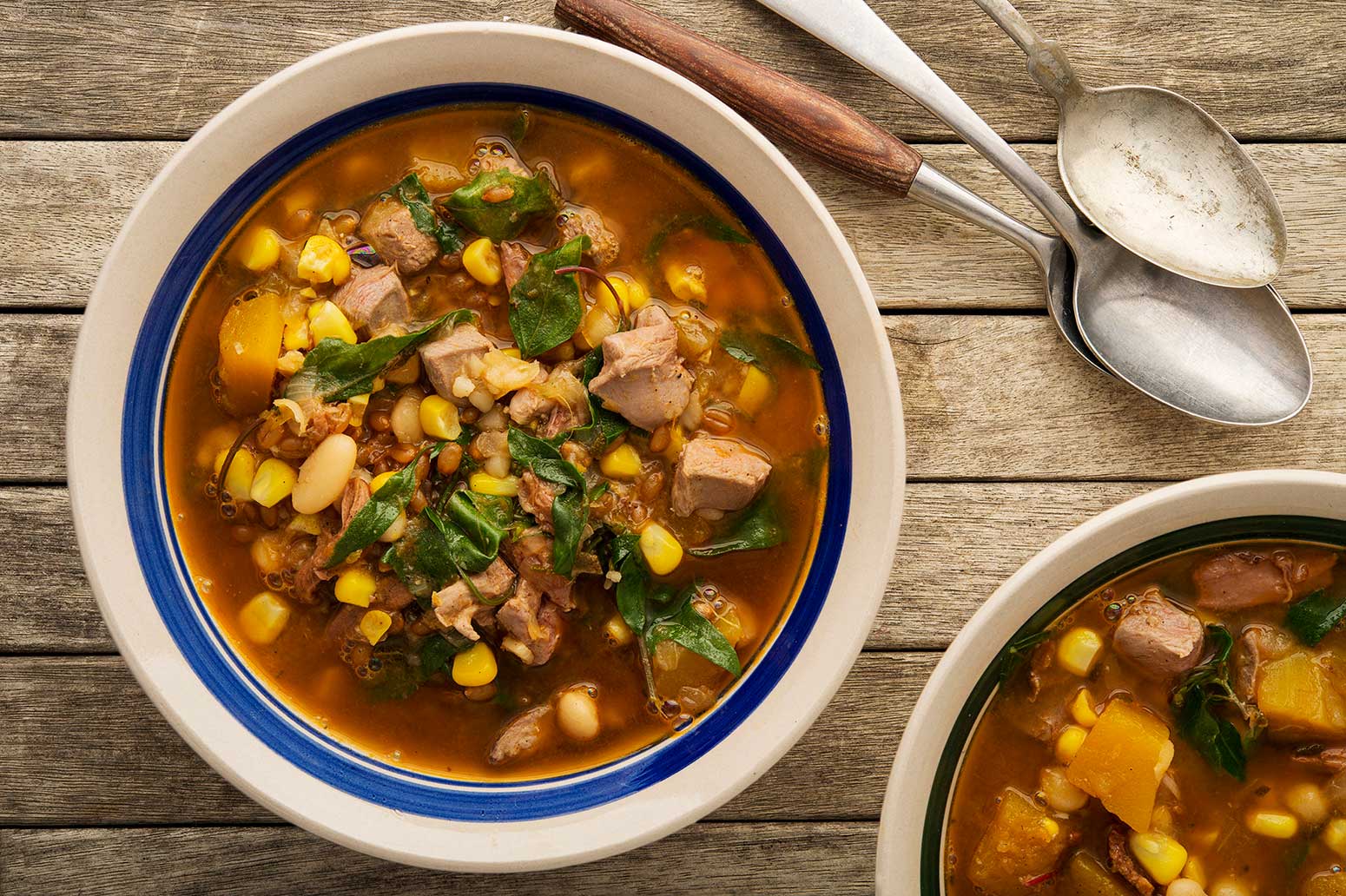
I know that a simple, how-to-make-stew post is not something you would normally see here on Hunter Angler Gardener Cook, but these are not normal times. Any of you who follow this site know that soups and stews are a big part of what I do.
And just to be clear, I am defining a stew as a bowl of goodness in which the things in the bowl are more important than the liquid. In a soup, the liquid is the star.
I make stew in much the same way no matter what the ingredients are. So if you read on, you will learn how to make a fantastic stew with whatever you have in the house. And that’s an important skill when grocery shopping isn’t all that easy — or if you live in a place where fancy ingredients simply aren’t available.
All great stews share some characteristics:
- Depth. Many layers of flavor that make you want to eat every last drop.
- Variety. You can make a great soup with just a couple ingredients, but a stew is literally a melting pot of goodness.
- Color. Sure, you can have a pale or an all-red stew, but great stews attract us with color.
- Texture. Everything from tender, slow-cooked bits to barely cooked, crunchy notes.
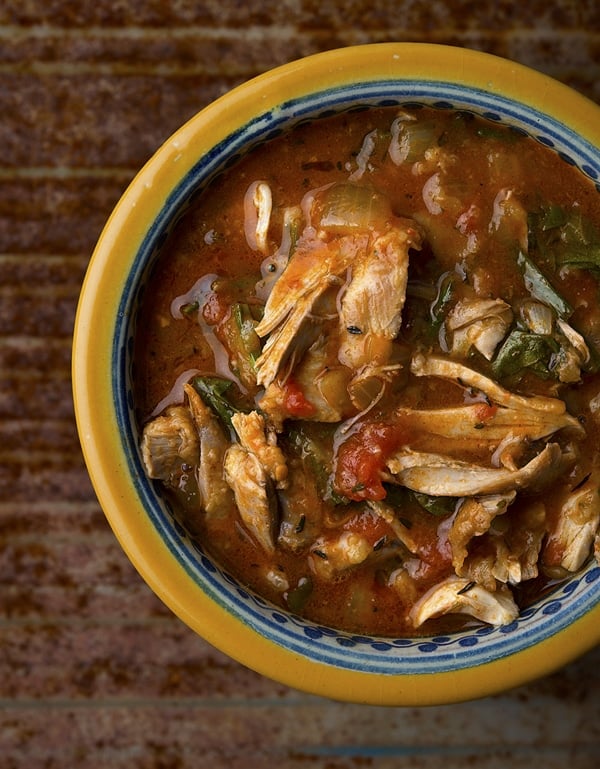
Let’s tackle each of these aspects one by one. Start with depth. How do you get there?
- Use broth, homemade or store-bought, or have the stew make its own. Water is great for clarity of flavors, broth better for a cohesive mix of flavors.
- Umami, the Japanese word for things that taste savory. Tomatoes, meat, mushrooms, miso, soy sauce are all great sources of umami. Use them in your stews. Cheese has a lot of umami, too, and grated cheese on top of a bowl of stew is often a great idea.
- Thickness. Roux, long-cooked potatoes or other starchy vegetables like yuca, sweet potatoes or plantains, starch, collagen from meats, or even just time itself can thicken the liquid in a stew.
- Smoke. Smoked ingredients add a ton of flavor, from ham hocks and turkey necks to smoked fish, smoked vegetables or even just smoked salt. In a pinch, yes, use liquid smoke.
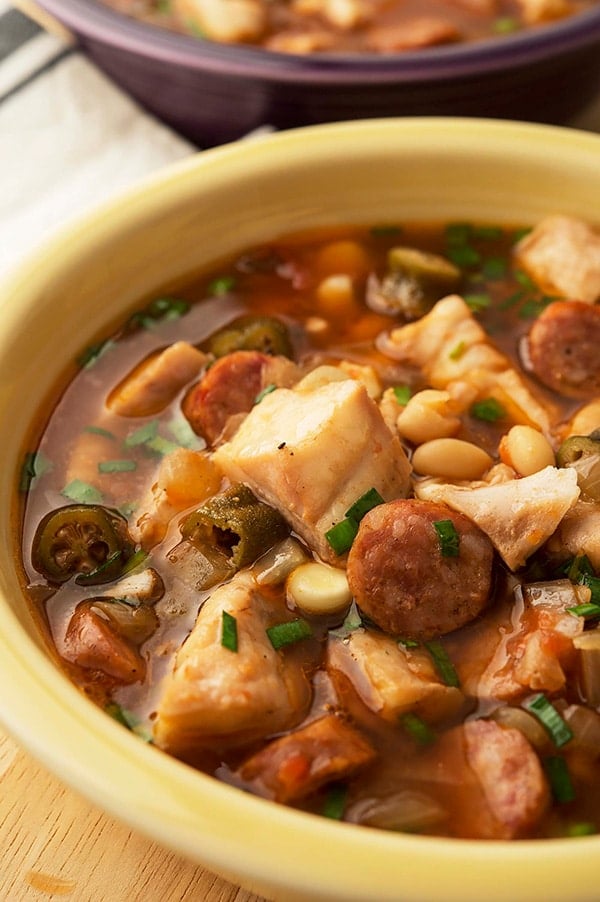
As for variety, it’s the spice of life, no? You can make your stew more interesting by varying your:
- Meats. Many of the great stews have several kinds, of different colors and textures. And remember, that in most cases, any dark meat will substitute for another, as will any light meat. This is also true with all crustaceans, and most fish — although you will want to go fatty fish with fatty fish, lean with lean.
- Vegetables. There are lots of root vegetables to play with. Get past the potato. Especially since there seems to be a run on potatoes now. Yuca, plantains, sweet potatoes, turnips, rutabagas, parsnips, carrots, oca tubers, the list is huge.
- Herbs. Adding all kinds of herbs very late in the game can radically change a stew. In general, add “hard” herbs like rosemary, sage and savory early in the process, and “soft” herbs like parsley, cilantro, dill, etc. at the end. I mostly add these when the stew is done, for color and brighter flavor. Dried herbs can go in at the beginning.
- Garnishes. Uncooked or lightly cooked garnishes are a great way for eaters to “choose their own adventure.” If you look at my recipes for pho, my Scandinavian “pho,” Mexican pozole and chocolomo, you will see this in action. As a general rule, I’m talking about raw vegetables, something crunchy like nuts, seeds or fried things, fresh herbs, hot sauce, fresh horseradish, sour cream, etc.
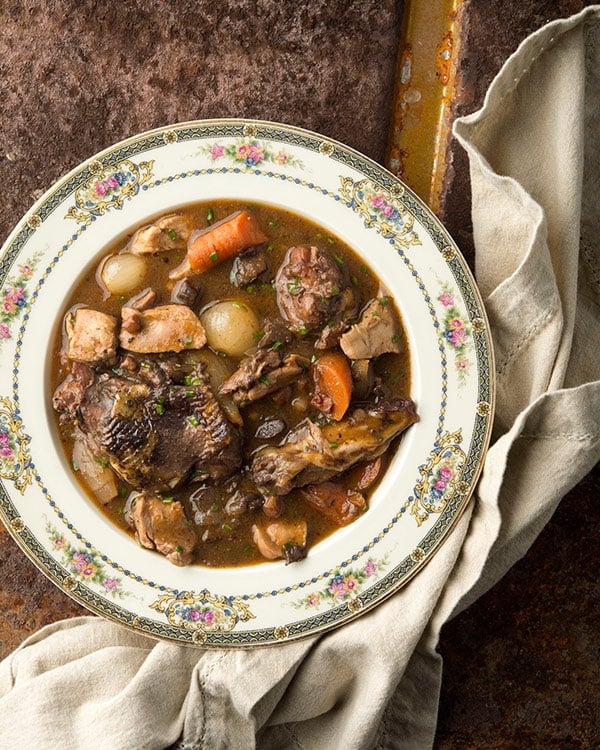
About color, it’s not 100 percent necessary to have lots of color in your stew, but everyone likes a colorful bowl of food. Color is the first thing people will see when they sit down to your stew. Make a good first impression. This plays into variety in a way, but being aware of color can make your stew better. I like greens and yellows for light meats, reds for dark meats, but a kaleidoscope is always pretty.
Finally, there’s smoke. Smoked things add a ton of flavor and depth to a stew. Consider using:
- Smoked meats or fish. The rest of a smoked pheasant or duck (everything but the breasts), is absolutely wonderful as a stew base.
- Hocks. Smoked turkey wings or ham hocks add a lot to a stew. Or a pot of beans, for that matter.
- Smoked salt. My secret ingredient. Have several, some heavy, some light.
- Smoked paprika. The secret ingredient of Spain.
- Smoked vegetables. Chipotles, anyone?
Some thoughts on substitutions for my existing recipes.
You can always sub out starch for starch. You’ll get different flavors and colors and textures, but they will often work fine anyway. No potatoes? Use turnips, or yuca or whatever. If I call for rice and you don’t have any, use barley, or wheat berries, or even rye berries. I like to use field corn, which is starchy, in many of my stews, but you can always use sweet corn instead.
Dry beans should be cooked separately if you have acidic ingredients in your stew because acidity can double or triple cooking time for dry beans. No need to soak dry beans overnight; that’a a myth. Canned beans should be rinsed and added at the end, as they are already cooked.
As for vegetables, it’s the same. any sort of onion can sub in for another. Again, this is all in a pinch. If I ask you to use leeks, it’s for a reason, but if you can’t get them, regular onions will do. No carrots? Leave them out or use parsnips, which are very similar, believe it or not. No peas? Use green beans.
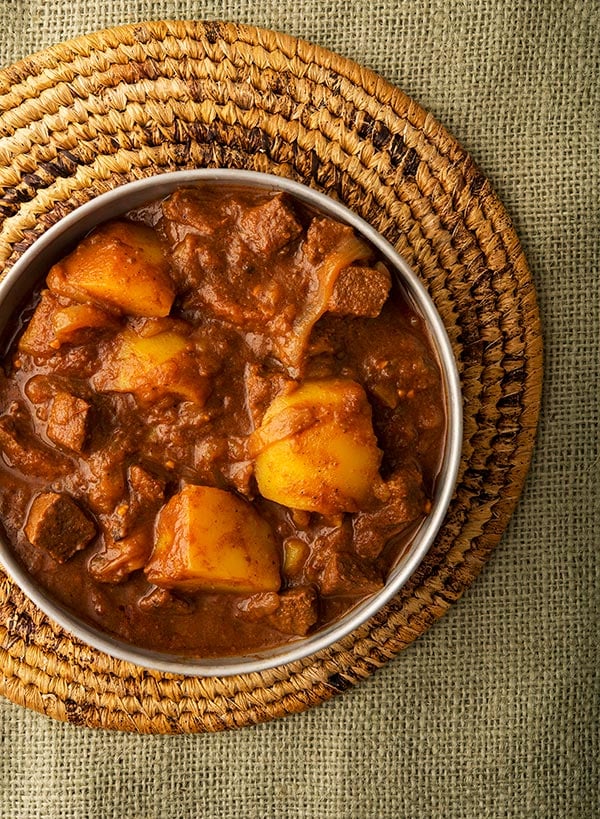
Tomatoes show up in a lot of my stews, and while yes, there are reasons to use crushed whole tomatoes in one place and puree in another, you can make a pretty damn good stew with any sort of tomato product. No tomato sauce? Dilute tomato paste. No paste? Add more sauce. It’s not rocket science. Incidentally, you add tomatoes to a stew for color, acidity and a touch of sweetness.
A word on meats. You generally have two choices with your meats: cut or shred. Most fish and seafood will be cut, most wild game shredded. This is not a hard and fast rule, but the leanness of game lends itself to long cooking and then shredding.

Venison Stews and Soups
Got deer? Elk? Or hell, even beef or lamb? Try any of these stews here.
Read MorePutting It Together
Finally let’s walk through how to make stew in a general sense. It’s a lot like building a house: Foundation, walls and floors, then paint and finishing touches.
You’ll often start by browning your meats. You can do this either in a 400°F oven or by searing in oil or fat in the pot you intend to make the stew in. You will salt your meats at this point. You don’t need to brown your meats, but it helps add depth because of the flavor you get from browning.
Most stews begin with some sort of onion and garlic mixture sauteed in some sort of fat. Each fat will add something different to the party, but they can all be subbed in and out depending on what you have. (I’ve already mentioned the onion substitutions above.) This is another chance to build flavor by browning the onions. Or not. Seared onions will be different from caramelized or simply simmered onions.
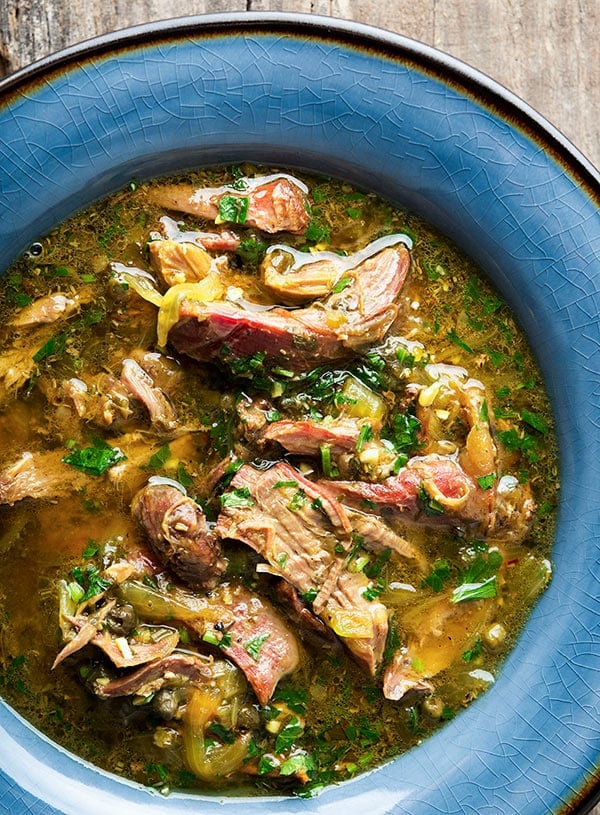
You’ll also add strong aromatics here, usually garlic, often crushed or minced ginger, dried herbs, chiles, or turmeric or other similar ingredients. This is usually where a seasoning paste goes in, too. Curry paste, tomato paste, berbere, sofrito, chipotle, you name it.
Now you will generally want to add a non-water or broth liquid. This is another opportunity for flavor. Wine is normal here, as are other alcohols. Coconut milk is another typical addition at this point, mostly in tropical stews. A puree of chiles is common in Mexico. Whey in Scandinavia.
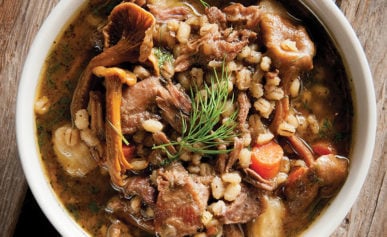
Soups, Stews and Broths
Here is my collection of duck and goose soups and stews. Most work with beef or venison, too.
Read MoreAfter that comes the broth or water, plus the vegetables that need the most time to cook, like root vegetables or grains. It is very important to add vegetables as needed, not all at once. Will the world end if you toss everything in at once? No, but if you want to know how to make stew properly, do this. You’ll thank me later.
Grains usually need the longest, followed by roots, then other vegetables, then fresh herbs.
Meats and fish fall into this same category. Tough cuts can often need 3 or more hours to fall off the bone. Put a potato in with the meat and it will dissolve. Conversely, cook a sausage for 3 hours and you will be sad; they generally only need 20 to 30 minutes. Tender cuts sometimes need almost no cooking at all. Strips of meat in pho are a good example of this, as are pre-cooked meats that need only be heated through.
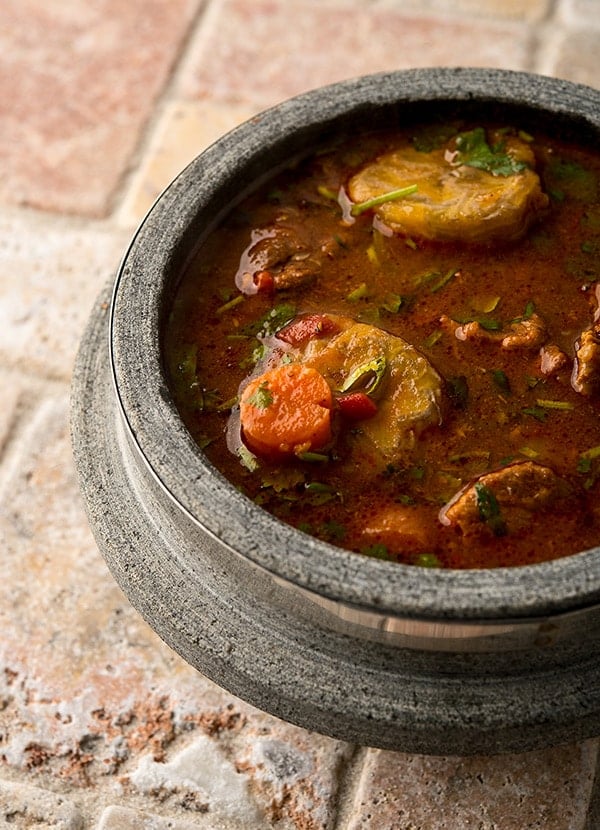
Salting your stew is important throughout the process. Add it little by little, leaving your stew slightly under-salted until right before you serve. This lets you add exactly the amount you need without oversalting. Why not wait until the end to salt at all? Because some things require time to absorb salt, like meats, grains and roots.
You final filips should be the addition of something acidic — citrus, pickle juice, vinegar, etc. — and a mess of freshly chopped herbs. These touches make a good stew great.
I hope all of this has helped you figure out how to make a fantastic pot of stew using whatever you have in the house. Good luck and I am happy to answer questions in the comments section.
Interested in learning more? My colleague David Joachim has written a fantastic book on food substitutions called The Food Substitutions Bible. I highly recommend it!
The Quarantine Chronicles

Edible Weeds: Eat Your Lawn
The best place to find edible wild plants might be no further than your own yard.
Read More
Black Mood, Red Sauce
It hasn’t all been sunshine and light these days. Our little family suffered a death recently, and its inevitability turned me inward, to that dish that gives me solace when all around me is black.
Read More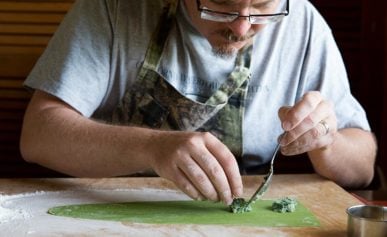
Stretching in Place
Quarantine has been a great opportunity to stretch yourself mentally, physically, and culinarily. Here are some ideas for you.
Read More
Time and Place on a Plate
When you can get out into the world again, do so with new eyes. Seeing what is around you when you hunt, fish or gather can inspire beauty on the plate.
Read More
Wasting Less, Living Better
Being thrifty in these times is a necessity. Here’s how I stretch and innovate in the kitchen using what I have handy.
Read More
Support the Volunteers
In the garden, which for many of us is a place of solace these days, you will often find useful plants just growing, here and there. Consider supporting them.
Read More
How to Salvage Freezer Burned Meat
When you can’t go to the store that often, you look into the depths of your freezer. Sometimes you don’t like what you see. Here’s how to deal with ancient frozen bits.
Read More
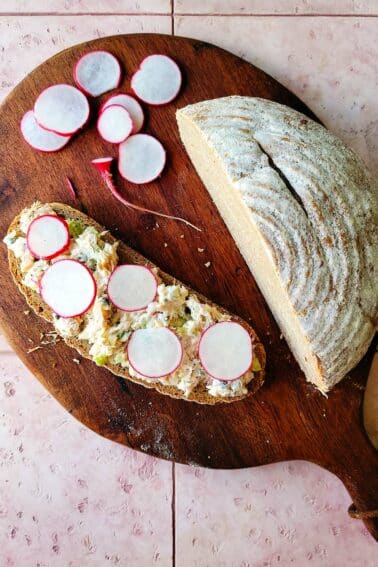
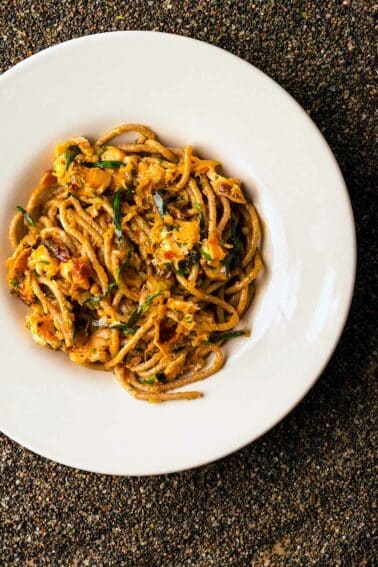
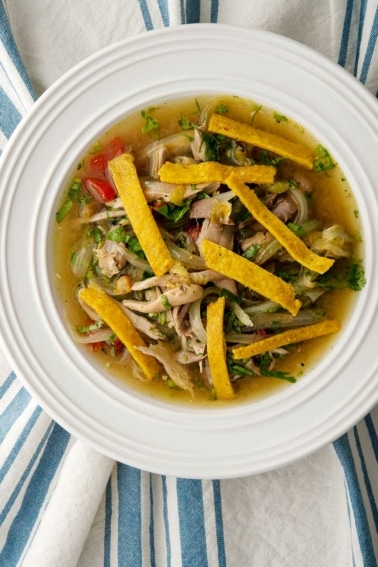
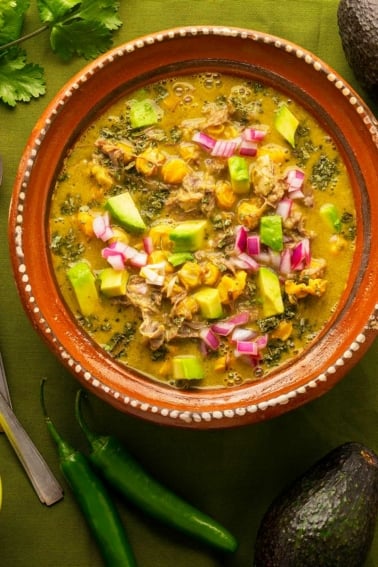
Enjoyed your article about stews. You really dissected all the levels in an easy to understand way. Any thoughts and/or recipes for rabbit stew? Just added rabbits to the homestead and have several in the freezer. Never cooked them before but want to learn. Thanks for any help you can offer
Amy: yes, I have several rabbit stews on this website. Look up stifado or just browse my page of rabbit recipes: https://honest-food.net/wild-game/rabbit-hare-squirrel-recipes/
As a missionary kid growing up in boarding schools off and on, we used to call this “Refrigerator Soup.” 🙂
Great stew advice ! About half the time I make a stew with red meat by the time the meat is tender and falling apart it tends to be bland with not a lot of flavor. The liquid and vegetable are spot on but the meat is unimpressive. Venison or beef chuck. Does an under salted liquid equalize the internal salt in the meat ? I have been messing with salt dry rubs 8-24 hours before browning the meat with some small gains. I hate having venison not be the star of any dish it’s used in. Thanks
Hello Mr. Shaw, I’ve currently got a supply of small animal tongues, as well as livers, hearts, and kidneys; do organs work well in stews? I’ve heard they’re very nutritious, so I kept the good bits, but now I’m not sure how to cook them. Also, what do you recommend for coons, possums, and beavers?
Enoch: Yes, there is a whole genre of offal stews, from menudo to mondongo, Texas sonofabitch stew, French pot au feu, etc. Everyone has their own innards stew.
As for the vermin critters, I’ve had beaver stew and liked it a lot. It is, more or less, like beef. Raccoon is OK, and possum, well, not a huge fan. But I know people eat them.
Have been reading your posts for quite some time now. I live fairly near you, in Cameron Park when we are not traveling. Loved your explanation re stew and you make it sound so easy (when we all know it’s not). The real secret is just to get in there and start doing it. I have only been doing it for about 40 years (and I am 80+) but what I know is that none of it is as hard as it sounds. It is really a matter of patience and attention to detail. I really like the way you did this.
If it works, I am sending you my Gumbo recipe if you want to use it or play with it. Now that I am imprisoned by this crummy virus, I have time to tell people like you how much I appreciate them. just found out I cannot attach it, so here it is. the format will undoubtedly be screwed up, but you will get the idea.
MY OWN GUMBO
2010, Ed Bouillon after years of fooling around with it
1 teaspoon Cayenne pepper
1 teaspoon garlic powder
2-3 tablespoons Cajun seasoning. homemade, Emeril’s, Chachere’s, other
½ cup all purpose flour for chicken
½ cup fine ground cornmeal for chicken
3-3½ pounds boneless, skinless chicken breast or thighs (cut in pieces)
2 teaspoons dried thyme
5-7 tablespoons vegetable oil
½ pound Andouille sausage (best you can find), sliced crosswise
½ pound linguiça (Portuguese sausage) (best you can find), sliced
1 cup preferably lard or olive oil or peanut oil or butter for roux
1 cup flour and probably more for roux
2-3 cups diced onion
1-1½ cup diced celery (half as much as onion)
1-1½ cup diced green and or red pepper (half as much as onion)
4-6 cloves garlic (minced)
2 bay leaves
5 cans Chicken Broth or 2 quarts of homemade stock (preferable)
1-2 pounds peeled and deveined shrimp, the largest you can afford
1 cup chopped green onions
1 cup chopped parsley
Salt and fresh ground pepper to taste
Cooked long grain white rice for serving
Mix half the Cayenne, half the garlic powder, half the Cajun seasoning, the flour and the cornmeal and put it in a large paper grocery bag. Sprinkle the chicken (trimmed of all fat) with the remaining Cayenne. garlic powder and Cajun seasoning and the thyme. Add the chicken to the bag. Roll the top shut and shake to coat. Set aside on a wire rack to shake off the excess flour mixture. Discard remaining coating.
Heat a little of the oil in a large cast iron skillet. Add the sausages and sauté until browned on both sides. Add more oil as and if needed. Remove with a slotted spoon (spider) to paper towels to drain.
In the same skillet, add the chicken (in batches if necessary- do not crowd) and brown the chicken pieces on both sides, adding more oil between batches as needed. Add to the sausages to drain.
In a clean large cast iron skillet, heat lard over medium heat. Once oil is hot, add flour and using a flat wooden spatula, stir constantly until the color of the roux is peanut butter brown or darker. You may, and I always do, add more flour from time to time to make this whole thing work. The darker the roux the “nuttier” the flavor. Note: To avoid burning/scorching the roux, start out using low heat and stir constantly until you know what you are doing. If black specks appear in the roux, it’s burnt; discard and begin again. At low heat, it may take up to forty-five minutes to prepare the roux. So don’t use low heat once you know how. Practice makes almost perfect. Remember – the darker the roux, the less thickening power it has so there is a delicate balance to maintain.
When the roux is the color you like, REMOVE FROM THE HEAT and immediately add onion, celery, and bell pepper. Constantly stir until you no longer hear or see it cooking. This stops the darkening of the roux.
Return to the heat and add the garlic and bay leaves. Sauté approximately 3-4 minutes or until vegetables are tender.
Meanwhile, heat the broth/stock in a saucepan. Add chicken broth/stock to the roux mixture, one ladle at a time, stirring constantly with a wooden spoon, until a good portion of the liquid is incorporated into the roux and your skillet is almost full.
Transfer the roux mixture to a large stock pot. Add chicken pieces and sausages with more broth/stock as needed. Bring to a boil and simmer for at least 30 minutes, adding more broth/stock as desired and stirring occasionally.
Just before serving, add the shrimp and cook until just barely done. Add green onions and parsley and season to taste with salt and pepper. Serve over cooked long grain white rice.
COOK’S NOTE ABOUT SAUSAGES: Locally the best I have found is from Morant’s on Franklin Boulevard in Sacramento. Most prepackaged sausage contains far too much fat. You can also use Tasso ham if you can find it. If you must use a commercial brand, such as Silva’s or Aidell’s, use the following method.
Put them in a large fry-pan with about ½ inch of water. Poke a few holes in each sausage with a sharp knife and turn on a low heat; Let them braise, covered or uncovered, for about 25-30 minutes so some of the fat comes out. (I learned this trick from my Mother when I was just a kid and didn’t even know why she was doing it.) Then drain on paper towels and slice them to use as above
how do you smoke salt? and along this line, can I smoke regular paprika?
Jim: You lay salt out in a thin layer and smoke it for several hours. It works even better if you dampen the salt, then smoke dry it. As for paprika, no. You need to smoke the peppers and then grind.
Hank – looked at your recipes a couple days ago and made my best Elk Stew ever and did it with what I had. Will be enjoying a few more times. Thanks for the guidance.